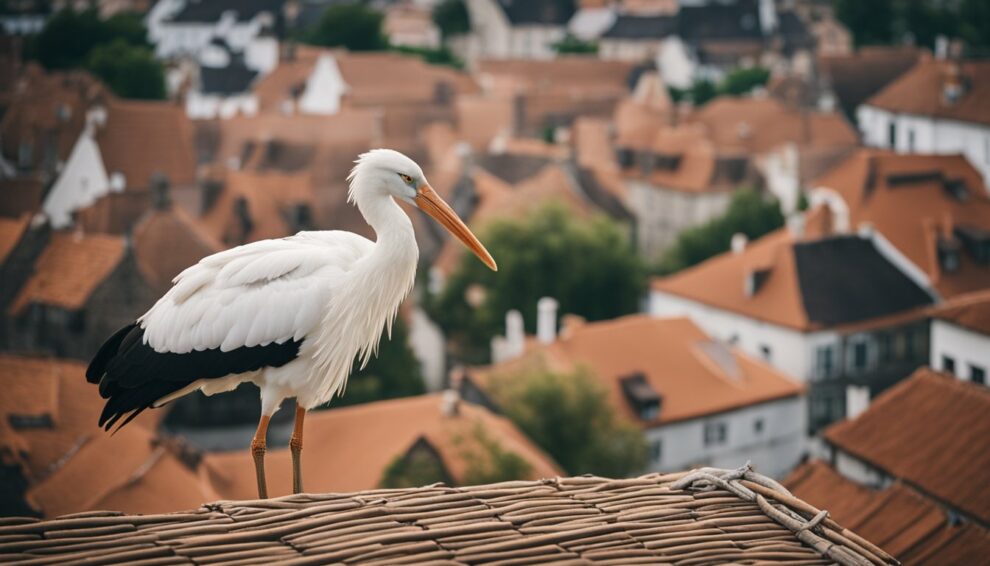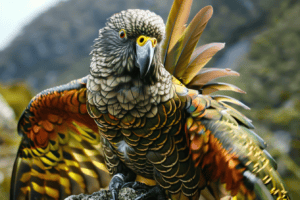Have you ever looked up to see a large, graceful bird soaring in the sky and wondered about its journey?
This could very well be a white stork, a creature that has shared a close bond with human communities for centuries.
Picture this: they build impressive nests atop roofs, chimneys, and poles, often in the heart of bustling villages.
These iconic birds, with their striking white feathers and contrasting red beaks, have become symbols of good luck and new beginnings in many cultures.

The white stork thrives alongside human habitation, benefitting from the mosaic of landscapes shaped by agriculture and human development.
Their history with humans is quite remarkable; from the folklore of storks delivering babies to homes, to giving names to places like Storkhill and Storrington in the UK.
In Armenia, they are a familiar sight, nesting close to people in an enduring partnership that extends over generations.
Ever noticed how often storks are depicted in children’s storybooks or nursery rhymes?
It’s clear they’ve always captured our imagination!
But why do storks prefer to live so close to us, you wonder?
Well, they’ve learned that human settlements can be full of tasty treats like insects and small mammals that make for a perfect stork buffet.
Also, storks are quite social; much like people, they enjoy the company of their kind and the safety that comes with community living.
This historical partnership between white storks and humans has even sparked conservation efforts to reintroduce these majestic birds into areas where they once thrived, like in Britain, after centuries of absence.
Isn’t it wonderful how humans and storks can help each other out?
The White Stork: A Winged Friend through History

The White Stork has gracefully danced across the skies for centuries, intertwining its existence with human cultures through various symbols and traditions.
They have been a recurring character in our collective narrative, reminding us of the harmony possible between humans and nature.
Symbolism and Folklore Across Cultures
In the tapestry of folklore, the White Stork stands out with a bold stroke of good luck and fertility.
Its presence has been woven into countless cultural motifs, including the well-known fairy tale where storks deliver newborns to expectant parents.
This imagery is not just confined to European narratives but spans multiple continents.
From the rooftops of Europe to the heart of Africa, these birds have been celebrated and respected as emblems of community spirit.
In some cultures, a stork nesting atop one’s roof is a harbinger of positive fortunes.
Artwork and emblems frequently feature storks, particularly in stories and celebrations, highlighting their significant cultural impact throughout history.
Storks in Our Stories and Celebrations
Have you ever wondered how these majestic birds became such common figures in our stories and festivities?
The White Stork’s habit of residing close to human settlements has made them a recurring element in human tradition.
They star in tales that have transcended generations, like Aesop’s fables where they represent both wit and moral virtues.
During festivals, the silhouette of the White Stork is often seen adorning banners and decorations, a tribute to its status as a bearer of prosperity and peace.
Their presence in celebrations is not just decorative but emblematic, encapsulating the spirit of the community and the lingering belief that they truly bring something magical into our lives.
Coexisting with Humans: Storks in Our Midst

Storks have a long history with human settlements, often seen as symbols of good luck.
These majestic birds have learned to thrive among us, building their lives in our altered landscapes.
The Stork’s Adaptation to Human Altered Landscapes
Over the centuries, storks have shown a remarkable ability to adapt to landscapes altered by human activity.
Farmlands and wetlands are especially significant, as they provide a mosaic of habitats that storks can use for foraging.
These birds often feed in shallow waters along rivers, or patrol through fields, following the plow to snatch up any insects or small animals turned up from the soil.
The Importance of Human-Made Structures for Nesting
When it comes to settling down and starting a family, storks show a distinct preference for human-made structures.
Chimneys, rooftops, and poles make ideal platforms for their large nests.
In some areas, people have even constructed special nesting platforms to attract breeding pairs, recognizing their role in local biodiversity and the joy these birds bring to human observers.
Benefits and Challenges of Urban Stork Populations
The presence of storks in urban areas comes with its own set of pros and cons.
On one hand, these birds play a vital role in controlling pests, and their successful breeding is often a clear sign of a healthy environment.
But they can also face challenges, such as the risk of collision with power lines or loss of natural feeding grounds.
Proper management and conservation efforts can help ensure that storks continue to coexist peacefully with humans for generations to come.
Protecting Our Feathered Companions: Conservation Efforts
Understanding the plight of the White Stork and taking strides in their recovery and habitat restoration form the backbone of their ongoing conservation.
The Plight of the White Stork and Its Causes
The White Stork, a revered symbol of renewal across many cultures, faces challenges largely due to human activity.
Habitat loss, driven by urbanization and intensive farming, has significantly reduced the areas suitable for their nesting and feeding.
Storks depend on a mosaic of wetlands and grasslands, environments that are rapidly vanishing or being altered across their migratory routes.
Compounding this is climate change, which disrupts their migration patterns and breeding times.
Success Stories of Stork Recovery and Reintroduction
However, not all news is grim. Conservationists have been hard at work, and their efforts are bearing fruit.
One flagship endeavor is the White Stork Project, which focuses on re-establishing breeding populations in areas they’ve vanished from.
This program involves a blend of breeding programs that raise storks in safe environments before they’re reintroduced into the wild.
Creating Safe Havens: Wetland Restoration and Private Reserves
To support the storks, wetland restoration projects are critical.
These initiatives reconstruct the natural environments storks once thrived in, often on lands provided by private reserves.
This not only benefits the White Storks but a whole ecosystem that depends on wetland biodiversity.
Conservation thus goes hand in hand with active land stewardship, where landowners are encouraged to maintain practices that support stork habitats.
In this journey of conservation, every step counts, and the efforts put towards protecting the White Stork offer hope for this species and the broader ecosystem they represent.
The Magic of Migration: Tracking the Stork’s Journey

While many birds migrate, the white stork has a special place in our hearts and history.
This section will look at how these incredible birds make their annual journey and how science and society play a role in understanding their path.
The Fascinating Phenomenon of Stork Migration
Each year, the skies chart a story of endurance and survival, with white storks embarking on a monumental journey.
They travel from European breeding grounds to the warmth of Africa and then back again.
Understanding this migration pattern has always been a human curiosity.
Historically, the appearance of a stork with an African spear through its neck irrefutably revealed that these birds traversed continents.
This event was more than just a curiosity; it was a window into the migratory habits of these birds, showing their fortitude in the face of challenges both natural and manmade.
Scientific Insights through Tagging and Monitoring
The advancement of technology has unlocked secrets of the stork’s migration that were once beyond our grasp.
GPS-tagged storks give researchers a real-time look at the routes and habits of these migratory birds.
This data is pivotal, revealing new migratory strategies and routes that adapt over time.
Scientists can now observe that not all white storks journey to Africa; some now choose to winter in the warmer parts of southern Europe, often near landfill sites that provide a steady food source.
The use of these sites has influenced migratory patterns, a shift reflecting the stork’s ability to adapt to human-altered landscapes.
Engaging Communities in Stork Migration Studies
The relationship between white storks and humans goes back for centuries, and their migratory patterns hold a special place in cultural lore and scientific study.
Young readers, isn’t it exciting to think how birds flying over your head have stories to tell?
As these birds soar across borders, people from different regions share in tracking their progress, contributing to conservation efforts and citizen science projects.
By observing the nesting and return of storks, communities become active participants in a larger story, highlighting the importance of global collaboration for understanding and protecting these travelers of the sky.
Frequently Asked Questions

White storks have a long history of association with human habitats, often being a common sight perched atop rooftops or chimneys.
This relationship has piqued the interest and curiosity of many, leading to various questions about their behaviors, myths, and interactions with human settlements.
How do white storks adapt to living alongside humans?
White storks exhibit a remarkable adaptability to living near human settlements.
They often build their nests on structures such as rooftops, chimneys, and poles, which offer safety from ground predators.
The proximity to humans doesn’t seem to bother them, possibly due to the plentiful food sources found in agricultural fields and the reduced need to compete with other wildlife for nesting spots.
In what ways have human settlements influenced the nesting habits of white storks?
Human settlements have provided white storks with artificial platforms that are often safer than natural alternatives, leading to a preference for nesting on buildings and other man-made structures.
Their nesting habits are closely linked to the availability of open land for foraging, which has increased with certain types of agricultural practices and land use.
What are some peculiar behaviors of white storks during their migration?
During migration, white storks often take advantage of thermal updrafts to conserve energy, which requires them to circle in the air.
This behavior, known as “kettling,” enables them to glide for long distances without much flapping.
Interestingly, they avoid crossing large bodies of water such as the Mediterranean Sea, opting instead for a detour over land.
Can you explain how the myth of storks delivering babies originated?
The myth of storks delivering babies likely originated from European folklore, tying into the storks’ springtime return to their nesting sites in Europe, coincident with an increase in human births due to seasonal cycles.
Their caring behavior towards their young may have also contributed to the association with bringing new life.
How does the white stork’s choice of habitat affect its migration patterns?
The white stork’s migration patterns are influenced by habitat preference, as they tend to migrate between areas that offer similar open landscapes.
They travel from European breeding grounds to wintering sites in Africa, often avoiding long flights over water.
Conservation of their habitats along these routes is crucial for their successful migration.
What unique characteristics help distinguish the white stork from similar birds like herons?
The white stork can be distinguished from similar birds like herons by its red beak and legs, contrasting with the heron’s longer, yellowish beak and darker legs.
The storks also have a sturdier build, a straighter neck in flight, and a habit of clattering their beaks, which is not observed in herons.









